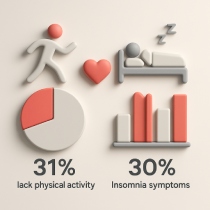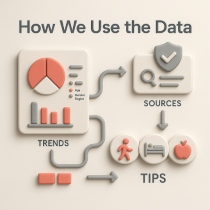What We Do
Our focus here is taking serious studies, stats, and global trends, then breaking them down so anyone can see what’s going on with their own habits. Then we translate that into patterns, trends, and charts with plain-language takeaways. Our goal is to help you see where you are, compare with what others are doing, and identify simple steps to improve.
Why It Is Important

At some point in your life, you’ve probably felt tired but brushed it off. Sometimes, people have concerns about whether they are eating well enough or under stress. All these daily things do add up. For example:
- Worldwide, about 31% of adults aren’t getting enough physical activity. That’s nearly 1.8 billion people at risk for things like heart disease, diabetes, etc.
- More than 30% of adults globally have had insomnia symptoms at some point.
We believe knowing this helps you make better choices, not feel guilty.
What the Numbers Say
Here are the latest stats we’ve found that show how people are doing globally and what you might want to keep an eye on:
Physical Activity Levels
- 31.3% of adults worldwide (around 1.8 billion people) in 2022 were insufficiently physically active, falling short of WHO’s guideline of 150 minutes moderate exercise per week.
- Recent data shows that the numbers are up from about 23.4% in 2000 which means physical inactivity is increasing in many countries.
- Women are generally more inactive than men globally (about 33.8% vs. 28.7%) and inactivity increases with age, especially after 60.
Sleep & Sleep Disturbance
- Nearly one-third of adults (≈30-33%) report getting less sleep than recommended.
- Trouble falling or staying asleep is fairly common: around 14.5% of U.S. adults reported difficulty falling asleep most or every day in the past month in 2020. Staying asleep most or every day was about 17.8%.
- Globally, insomnia affects more than 16% of people.
Other Dimensions: Stress, Disruption, Sleep Perception
- In a global survey in 2024, about 22% of respondents said they “just live with” poor sleep, rather than trying to fix it.
- Across many countries, stress and anxiety are major causes of sleep disruption, often ranking higher than lifestyle or environment in people’s minds.
How We Source Our Data
We pride ourselves in offering nothing but credibility. That’s why our insights are backed by trusted global institutions and peer-reviewed studies. We regularly draw from:
- World Health Organization (WHO)
- Food and Agriculture Organization (FAO)
- Gallup Global Polls
- Statista and OECD data sets
- World Mental Health Report
How We Use the Data
We believe that data is helpful only when you can see how it relates to your life. That’s why here’s what we do with these stats:

- Charts + Visuals: We show global trends (e.g. % of adults being physically inactive), broken down by age, gender, region. Seeing curves and gaps helps you know where you might fall.
- Simple Comparisons: “Here’s how people in your age group are doing” or “In your region, how sleep habits compare to global norms.”
- Actionable Tips: If you see a pattern (many people sleeping less than 7 hours, many lacking activity), we also suggest tiny habit shifts you can try. For example: add a 10-minute walk, reduce screen time before bed, etc.
- Credible Sources: WHO, peer-reviewed research, global health surveys. We double check for consistency and highlight any gaps in the data.
Who Benefits from These Insights
Self-Care Data Foundation is designed for everyone who wants to live better, but specific groups benefit in unique ways:
- Individuals who want better rest, more energy, less stress
- Communities & workplaces trying to focus on wellness programs
- Health educators & practitioners who need simple visuals to explain trends
- Researchers & policymakers who want to see where habits are drifting and where interventions might help
What Our Data Sources Are
We use data that’s recent, reliable, and globally relevant:
- WHO fact sheets & reports on physical activity, health behavior.
- Large global health surveys & meta-analyses published in peer-reviewed journals.
- Sleep studies & global sleep surveys (e.g. ResMed) that show subjective sleep quality and behavior.
- National data sets (e.g. U.S. CDC, etc.) when they offer finer detail on demographics or behaviors
How to Use These Insights in Your Life
- Making small changes based on clear data can add up. Here are tips grounded in what the numbers are showing:
- If you’re not meeting 150 minutes/week of activity, start with small wins: walk 10 minutes more each day, use stairs, do short body-weight exercises.
- Prioritize consistent bedtime routines; reduce screen time before bed. If you notice trouble falling or staying asleep, tracking sleep (even with your phone or an app) can highlight patterns.
- If stress or anxiety is affecting sleep, see what small steps help: journaling, breathing exercises, perhaps professional help when needed.
- Compare your habits to what people in your region/age are doing—seeing you’re not alone often helps motivate change.
Our Mission & Why It’s Important
We want to make self-care smarter. Instead of vague advice, we provide clear, evidence-based insight so you understand what habits are common, what health risks are rising, and what practical changes you can make.
In a world saturated with health tips, we’re building a place where data is accessible, digestible, and directly usable. Because small improvements in sleep, movement, stress over time = big improvements in wellbeing.
Get Involved & Stay Updated
We publish regular reports, share charts, and update insights as new data emerges. If you’re interested:
- Sign up for summaries: weekly or monthly snapshots of global & regional health habit trends
- Use our charts for your own planning: whether for your personal goals, workplace wellness, or community projects
- Suggest topics: Is there a specific age group, region, or habit you want numbers on? We’ll dig
At Self-Care Data Foundation, our focus isn’t calling you out on what you’re doing wrong. We take pride in helping you see what’s going on and giving you tools to gently shift toward healthier habits. When you know the numbers, you get a choice. And with small choices, real change becomes possible.
